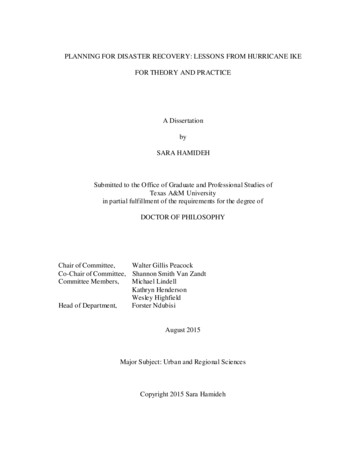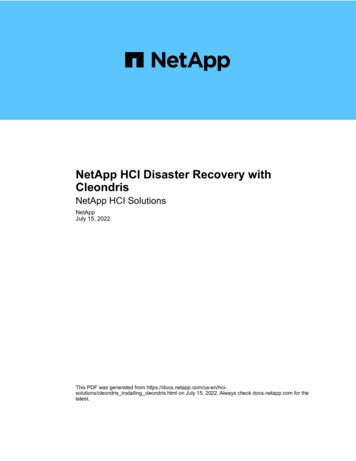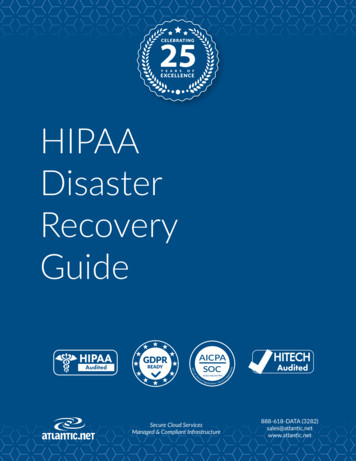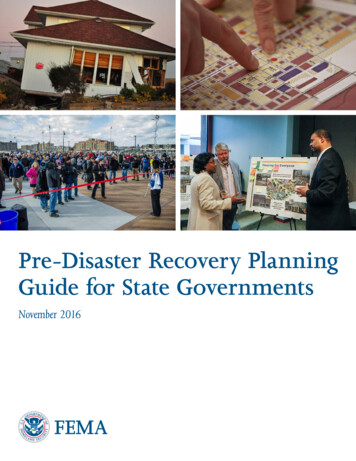
Transcription
PLANNING FOR DISASTER RECOVERY: LESSONS FROM HURRICANE IKEFOR THEORY AND PRACTICEA DissertationbySARA HAMIDEHSubmitted to the Office of Graduate and Professional Studies ofTexas A&M Universityin partial fulfillment of the requirements for the degree ofDOCTOR OF PHILOSOPHYWalter Gillis PeacockChair of Committee,Co-Chair of Committee, Shannon Smith Van ZandtCommittee Members,Michael LindellKathryn HendersonWesley HighfieldHead of Department,Forster NdubisiAugust 2015Major Subject: Urban and Regional SciencesCopyright 2015 Sara Hamideh
ABSTRACTRecovery is the least researched and prepared-for phase in the disastermanagement cycle, but the critique of the post-Katrina’s planning has begun to getresearchers’ attention with an emerging consensus on the value of recovery planning andits timing. My dissertation focuses on improving recovery planning by asking “how canthe recovery planning process and outcomes following Hurricane Ike in Galveston,Texas inform theories of recovery planning?” This inquiry is addressed in three articles.The first article is an integrative review of the recovery planning literature,theories of planning and plan quality to lay out evaluation criteria. Recovery planningshould be proactive, driven by local leadership, long-term and broad scope based onaccurate data. Success of a recovery plan depends on setting transformative andrestorative goals, alternative plausible futures and flexible policies. While federalrecovery programs use several of these principles, they are criticized for short timeframe, project-oriented and a prescriptive approach.The second article undertakes a qualitative analysis of recovery planning inGalveston. Resistance to start planning early reflected a lack of capacity. Hence, whenplanning started, it was based on limited fact-basis and expertise. The planning processwas open and transparent, yet not adequately representative; and deliberation onimportant issues fell short. The result was a list of projects, not a plan, which failed togain political and legal approval.ii
The third study is an assessment of population, economic, and housing recovery.Population of Galveston is slowly restoring its pre-Ike level, but I found disparitiesamong neighborhoods and race/ethnic sub-populations. Changes in shares of industriesfrom job market and composition of jobs show that Ike was an interruption andacceleration to longer and broader trends in the local economy. Recovery of housing haseither failed or been severely thwarted at the aggregate level. At the disaggregate level,the lag is even larger for damaged duplexes and multifamily units.Finally, I synthesize the findings of the three studies and suggest lessons forrecovery planning practice and questions for future research to further inform ourknowledge of the opportunities and challenges in disaster recovery planning.iii
DEDICATIONFor maman and babaiv
ACKNOWLEDGEMENTSI would like to express my deep gratitude to my advisors, Dr. Peacock and Dr.Van Zandt, for the mentorship and patient guidance they provided to me all the wayfrom when I became interested in studying disasters through to completion of thisdegree. I am truly fortunate to have had the opportunity to work with such inspiringscholars. I would also like to thank my committee members, Dr. Lindell, Dr. Henderson,and Dr. Highfield, for their steady guidance and thought-provoking suggestions over thecourse of this research.I am grateful to my friends and colleagues in the Hazard Reduction and RecoveryCenter, and the faculty and staff of the Department of Landscape Architecture and UrbanPlanning for their friendship and support. I also want to extend my appreciation to theNational Education Foundation, which provided the funding for the data collection.Finally, I cannot thank my mother and father enough for everything they do forme.v
TABLE OF CONTENTSPageABSTRACT .iiDEDICATION . ivACKNOWLEDGEMENTS . vTABLE OF CONTENTS . viLIST OF FIGURES .viiiLIST OF TABLES . ixCHAPTER I INTRODUCTION . 1Literature Review . 2Purpose . 8Structure of the Dissertation . 9CHAPTER II 1ST ARTICLE: THEORETICAL PERSPECTIVES THATINFORM DISASTER RECOVERY PLANNING . 11Introduction . 11Methodology. 16Findings . 19Context of recovery planning . 20A successful recovery planning process . 30A successful recovery plan . 50Federal recovery policy . 56Improving federal recovery policy . 62CHAPTER III 2ND ARTICLE: RECOVERY PLANNING AFTER HURRICANEIKE: GALVESTON, TX . 69Introduction . 69Literature Review . 70Study Area . 79Methodology. 81Data sources. 81Sample of interviewees. 82vi
Data collection: interview guide. 83Analysis strategies . 84Results . 88Recovery planning process by LTRC. 88The recovery plan by LTRC . 106Conclusion . 113CHAPTER IV 3RD ARTICLE: PLANNING FOR LONG-TERM COMMUNITYRECOVERY: LESSONS FROM MEASURING RECOVERY AFTERHURRICANE IKE . 117Introduction . 117Research Question and Hypothesis . 118Measurement, Data and Analysis Methods . 121Analysis and Findings . 127Population recovery . 127Economic recovery . 137Housing recovery. 150Conclusion . 165CHAPTER V CONCLUSION. 166What I Found in the First Article . 166What I Found in the Second Article . 171What I Found in the Third Article . 174Recommendations . 177For practice . 177For research . 179REFERENCES . 180APPENDIX 1 . 198APPENDIX 2 . 200APPENDIX 3 . 203APPENDIX 4 . 207APPENDIX 5 . 212vii
LIST OF FIGURESPageFigure 1. Location of Galveston Island . 120Figure 2. Population trends: with and without Ike . 128Figure 3. Galveston population: annual exponential change rate . 130Figure 4. Population census 2000-census 2010. 131Figure 5. Race-ethnicity 3-year ACS estimates, Galveston . 134Figure 6. Absolute population change by Block Group: from ACS 2005-09 toACS 2009-13. 136Figure 7. Relative population change by Block Group: from ACS 2005-09 toACS 2009-13. 137Figure 8. Number of jobs by industry (main industries: 5% share),Galveston: 2002-11 . 139Figure 9. Share of industry from total number of jobs, City of Galveston: 2002-11 . 142Figure 10. Number of jobs by earnings . 145Figure 11. Percent of jobs by earnings . 146Figure 12. Percent of Workers Employed in Galveston but Living Outside(primary jobs). 149Figure 13. Percent Change from 2008 Assessed Value for each Residential Type . 151viii
LIST OF TABLESPageTable I. Codes that characterize circumstances for recovery planning, Atlas.ti output . 22Table II. Codes that identify success criteria for recovery planning process . 31Table III. Codes that identify success criteria for recovery plan . 52Table IV. Indicators of recovery . 125Table V. Total population estimates, Galveston, TX . 129Table VI. Population composition change from Census 2000 to Census 2010 .130Table VII. Population composition change (estimates) from ACS 3-year 2007,to ACS 3-year 2010 and to ACS 3-year 2013 . 133Table VIII. Change in shares of industries from job market: 2007-2011 . 144Table IX. Change in composition of jobs by earning: 2008-2011 .147Table X. Comparison of share change in job categories by earning: 2008-2011 . 147Table XI. Average assessed value by housing type, 2008-2012 only Galveston.152Table XII. Number and percent of damaged houses reaching restoration levelsfor each housing type Only Galveston .154Table XIII. Indexed average appraised values of single-family, multifamilyand duplex houses before and after hurricane Ike, by extent ofdamage. Only Galveston . 156Table XIV. Definitions and descriptive statistics for variables used incorrelation analysis- Only Galveston . 161Table XV. Partial correlations of damage with neighborhood characteristics . 162Table XVI. Partial correlations of restoration time with:.163Table XVII. Partial correlations of recovery rate with. 164ix
CHAPTER IINTRODUCTIONRecovery is the least researched and prepared for phase in the disaster cycle(mitigation, preparedness, response, and recovery) (Blanco et al., 2009; Leonard &Howitt, 2010; Olshansky, 2005a; Olshansky & Chang, 2009; Peacock, Zhang, & Dash,2006; Zhang & Peacock, 2010). Furthermore, long-term recovery planning, particularlyby localities, has received even less attention. However the widespread critique of thepost-Katrina’s planning process has recently begun to get disaster researchers’ attention.This dissertation will focus of this neglected area of long-term disaster recovery.The overarching question of this dissertation is “how can recovery planningprocesses and the nature of long-term recovery following hurricane Ike in Galvestoninform theories of community planning processes in general and recovery planning inparticular to improve recovery processes?” This inquiry will be addressed in threearticles with more specific questions. The first paper will engage in an integrativeliterature review examining theories of community planning, the newly emergingliterature on post-disaster recovery planning, Federal guidelines for post-disasterplanning, and the general literature on community recovery asking two primaryquestions: 1) what are the unique features of post-disaster recovery planning that presentchallenges and important considerations for planning theory and 2) what can planningtheories offer to improve post-disaster recovery planning from how it has occurredaccording to the literature and guidelines specified by the United States Disaster1
Assistance Framework developed by the Federal Emergency Management Agency(FEMA)? The second article will undertake a qualitative case study analysis of the postIke recovery planning process in Galveston, Texas to answer the questions: how didGalveston’s post-Ike recovery planning process unfold, what strengths and weaknessesemerged during that process, and does this case inform still further the issues thatemerged in the first paper. The third paper will engage in a quantitative analysis andassessment of recovery at the community level, examining important dimensions of thecommunity including its population, economy, businesses, and housing. The keyquestion to be addressed is how can we characterize Galveston’s long-term recoveryafter Hurricane Ike?Lite rature ReviewDisasters are significant events which imply major harm and losses for those whoare exposed to them. The United Nations International Strategy for Disaster RiskReduction (UNISDR, 2004: 17) defines a disaster as “a serious disruption of thefunctioning of a community or a society causing widespread human, material, economic,or environmental losses which exceed the ability of the affected community or society tocope using its own resources”. Recovery from such events is defined by Smith andWenger (2007:23) as “the differential process of restoring, rebuilding, and reshaping thephysical, social, economic, and natural environment.”Multiple studies have found disparities in disaster impacts as well as recoveryoutcomes shaped by pre- impact conditions including physical vulnerability, hazardexposure (Highfield, Peacock, & Van Zandt, 2010, 2014) and socioeconomic factors2
frequently referred to as social vulnerability (Cutter, Schumann, & Emrich, 2014; Dash,Peacock, & Morrow, 1997; Zahran, Brody, Peacock, Vedlitz, & Grover, 2008; Zhang &Peacock, 2010). Social vulnerability considers the socioeconomic characteristics of thehouseholds that will impact their ability to prepare for, anticipate, cope with, and recoverfrom hazard events (Blaikie, Cannon, Davis, & Wisner, 1994). Social vulnerabilityindicators such as poverty, race/ethnicity, age, gender, household composition, andhousing tenure are found to explain the variability in household capacity for bothmitigation and recovery (Cutter, 1996; Cutter, Boruff, & Shirley, 2003; Highfield et al.,2014; Van Zandt et al., 2012) as well as damage and response (Van Zandt et al., 2012).Social vulnerability factors influence success or failure and also rates of recoverythrough various mechanisms (mediators) including access to assistance or resources forrecovery, mobility, and access to decision making procedures.In the disaster literature housing recovery has been thought of as a keycomponent of community recovery and is shown to be very inequitable. Recovery ofhousing in the US is largely a market-driven process (Peacock et al., 2006; Zhang &Peacock, 2010) which often tends to reestablish inequitable pre-disaster developmentpatterns and sometimes fail to reduce preexisting (physical and social) vulnerabilities todisasters. Inequalities emerge from what is initially perceived as a common communityof suffering and further exacerbate by the gains and profit from tragedy(Alesch, Arendt,& Holly, 2009). Disasters do not affect everybody equally. Peacock et al. (2007) point tothe unequal nature of damage among households as one of the most consistent findingsin the disaster literature: low- income and minority households tend to suffer3
disproportionately higher levels of damage in disasters (Bates, 1982; Bates & Peacock,1989; Blaikie et al., 1994; Bolin, 1982, 1993; Bolin & Bolton, 1986; Dash et al., 1997;Drabek & Key, 1984; Haas, Kates, & Bowden, 1977; Peacock & Girard, 1997;Quarantelli, 1982).Inequitable patterns of damage can set the stage for very different recoverytrajectories for minority, and particularly predominantly Black neighborhoods whencompared to Anglo neighborhoods (Highfield et al., 2014). While receiving higher levelsof damage, these households have limited access to both private and public resourcesimportant for permanent housing recovery due to various discriminatory factors such aspoor language skills and educational backgrounds, lack of mobility, weak capability torepay Small Businesses Administration (SBA) low interest loans which is the primarygovernmental program for the uninsured and underinsured households (Berke, Kartez, &Wenger, 1993; Bolin, 1982, 1985; Bolin & Bolton, 1983; Bolin & Bolton, 1986; Bolin &Stanford, 1991; Dash et al., 1997; Morrow, 1997; Phillips, 1993; Rubin, Saperstein, &Barbee, 1985).Racial and ethnic populations and the poor in the US are consistently found to bemore vulnerable to natural disasters, due to factors such as language, housing patterns,building construction, community isolation, cultural insensitivities, and social exclusion(Fothergill, Maestas, & Darlington, 1999; Fothergill & Peek, 2004). Marginalizedracial/ethnic groups are often excluded from community post-disaster planning andrecovery activities (Bolin & Bolton, 1983; Morrow, 1997; Morrow & Peacock, 1997;4
Phillips, 1993; Quarantelli, Abetz, & Dynes, 1985) and may be taken advantage of byprivate businesses.The connection between aspects of hazard assessment, particularly socialvulnerability, and differential recovery trajectories emphasizes the need for planning toreduce inequalities in recovery. Nonetheless, very little is known about how post-disasterrecovery planning processes or improvised recovery (Lindell, Prater, & Perry, 2007),shape or lead to inequalities. My qualitative case study on post-Ike recovery planningprocess in Galveston will explore this issue.Recovery is portrayed as an uncertain, conflict- laden process bounded by timeconstraints and a wide range of stakeholders, interests and funding sources involved;hence its outcomes are strongly influenced by decision making and institutionalcapacities (Berke et al., 1993; Bolin, 1993; Bolin & Bolton, 1983; Mileti, 1999; Peacock& Ragsdale, 1997; Rubin & Popkin, 1990). Previous studies have reported complexitiesand high level of uncertainty in post disaster situations where no single person ororganization is in charge, and there would be no simple solutions (Johnson & Hayashi,2012; Oliver-Smith, 1990; Olshansky, Hopkins, Chandrasekhar, & Iuchi, 2009;Olshansky & Johnson, 2010; Peacock & Ragsdale, 1997)From the sociopoliticalecology perspective, any outcome in the recovery process would emerge out of theinterplay of mutual contingencies, competing interests, and coalitions exercised througha variety of structural linkages(Bates & Peacock, 1989; Peacock & Ragsdale, 1997).Disasters have long-term impacts on community conflicts and cohesion in manydifferent ways (Bates & Peacock, 1989; Carroll, Paveglio, Jakes, & Higgins, 2011;5
Morrow & Peacock, 1997). Disagreements on possible changes in the post-disasterwindow of opportunity are found to be one of the sources of conflict. A multitude of newsuggestions and ideas usually emerge after a disaster. Some have resulted in new waysof thinking about communities, enhancing mitigation, and increasing communityinvolvement, while others reduced involvement, created dependency and increasedfuture vulnerability (Dash et al., 1997). Value orientations shape whether post-disasteropportunities are seized upon for the betterment of community such as improvedefficiency, equity or amenities (Berke et al., 1993; Bolin & Stanford, 1998; Olshansky,Johnson, & Topping, 2006). The political systems of impacted societies mightthemselves undergo formal and informal changes after a disaster due to emergence ofnew priorities and policy changes that gain support fro m segments of the community oras a result of the mistrust and blame toward authorities associated with the disaster itselfor the recovery process. There can also be reactions by powerful forces, thwartingpotential changes (Bates & Peacock, 1989; Morrow & Peacock, 1997; Olson, 2000).There is a general consensus among disaster researchers on the value of planningfor disaster recovery and its timing as a critical factor (Burby et al., 1999; Johnson &Hayashi, 2012; Leonard & Howitt, 2010; Olshansky & Chang, 2009; Olshansky,Johnson, Horne, & Nee, 2008; Olshansky et al., 2006). Communities need to plan inorder to deal with situations that include multiple stakeholders, agencies andorganizations inside and outside the disaster-hit community, conflicts of interests andlimited resources to fulfill long lists of priorities (Smith & Birkland, 2012). However6
recovery planning is found to be associated with a number of challenges as well asopportunities that make it distinct from normal-time planning processes.Recovery processes should be designed with the dynamic and evolving nature ofcommunities as complex systems in mind. In a post-disaster situation, normalcommunity dynamics are disrupted by the event and yet c hronic social vulnerabilityissues are often exposed. Nevertheless, rather than looking to the future, the disasterrecovery process is typically focused on a return to normalcy. Setting such direction forrecovery is a result of ignoring what many studies have shown, recovery is never areturn to the status quo ex ante, or the conditions as they were before the event; becausethe effects of disasters on communities are complex and long- lasting (Johnson &Hayashi, 2012). While there is a growing literature suggesting that planning is criticalfor the success of long-term recovery (Olshansky, 2005a; Olshansky & Chang, 2009;Olshansky et al., 2009; Olshansky et al., 2008), there has been little focus on howplanning actually works under the unique circumstances of each disaster and affectedlocalities (Olshansky & Johnson, 2010). We need more detailed examinations of how thecomplexities and conflicts often associated with post-disaster situations play intorecovery planning processes and influence their outcomes.Disaster, according to Olshansky et al. (2012) is an extreme, time compressedcase of the normal process of capital depletion and replacement. One of the challengesrelated to time compression is that decision- making for recovery must occur at a fasterpace than the information and knowledge necessary for planning generally flows(Johnson & Hayashi, 2012; Olshansky, Hopkins, & Johnson, 2012). Disasters often7
present opportunities to make rapid physical and social changes to a community throughredevelopment employing an influx of disaster-related resources. Ideally, a communityshould strive to fully coordinate available assistance and funding while seeking ways toaccomplish other community goals and priorities, using the disaster recovery process asthe catalyst (Spangle, 1986). However in practice, creating a balance between qualityversus speed and short-term versus long-term needs is challenging (Burby et al., 1999;Olshansky, 2005a; Olshansky et al., 2006). We need a better understanding of how theseconflicting priorities play out in the planning and decision making process as well ashow localities decide and plan for creating a new normal while seizing the opportunitiesfor long lasting changes.PurposeThe overarching purpose of this study is to improve recovery-planning practiceand inform recovery-planning theory through the experience of Galveston afterhurricane Ike. My approach is novel in the sense that I will combine quantitativedescription and analysis of recovery patterns with a qualitative account of recoveryplanning. The important aspects of recovery, including complexities, conflicts andcontentions, opportunities, time compression, inequalities and disparities and delays willbe linked thorough a mixed method approach. This study seeks to examine how recoveryplanning can influence the nature of recovery processes based on the experience ofGalveston. Most studies do one of the two things; they either provide a qualitativeaccount of recovery planning and process (Olshansky & Johnson, 2010); or measure therecovery outcomes in terms of various dimensions such as gains or losses in population,8
employment, sales or housing. In this series of articles I will link the quantitativeassessments of recovery with a qualitative understanding of reco very planning seeking toexamine how conflicts, compression, and opportunities played out in the recoveryplanning process. This study will have the following contributions: Informing study of disaster recovery planning with planning theory Informing planning theory with insights from post-disaster recovery as a especialplanning situation Measuring recovery of Galveston from Hurricane Ike Informing recovery planning with lessons from GalvestonStructure of the DissertationI will first review the emerging literature on post-disaster recovery planning tolay out how one would evaluate a good recovery planning process and what issuesshould be addressed in the recovery plan (process and content). Next, I will review thetheories of planning and evaluate their application in the unique post-disaster situation.This review will provide ideas about how to engage in recovery planning, and whatcontent to address and include in the recovery plan. This framework of an ideal processand content for recovery planning will be used then to evaluate FEMA’s programs andguidelines for recovery planning. The second study, my qualitative case study ofplanning process in Galveston, provides an actual case to examine the strengths andweaknesses of planning process and content according to theoretical perspectives ofrecovery planning. It will also test the ideas for successful recovery planning and canreveal new issues in the Federal recovery planning guidelines and procedures. The third9
study is a quantitative assessment of community recovery in different dimensions.Findings of these three independent but related studies will be synthesized in aconclusion article. I will speculate about the impact of planning process and content inGalveston (from the second study) on recovery outcomes in various dimensions (fromthe third study). The story of planning and recovery processes from Galveston’sexperience, will offer new understanding of the challenges of post-disaster recoveryplanning and new insights that perhaps will better insure resilience as a long-termoutcome.10
CHAPTER II1ST ARTI
the recovery planning process and outcomes following Hurricane Ike in Galveston, Texas inform theories of recovery planning?" This inquiry is addressed in three articles. The first article is an integrative review of the recovery planning literature, . literature on post-disaster recovery planning, Federal guidelines for post-disaster










